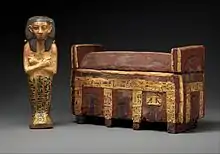Wahneferhotep was an ancient Egyptian king's son who lived in the Thirteenth Dynasty, around 1700 BC.
Attestation

Model coffin and shabti of Wahneferhotep, Metropolitan Museum of Art.[1]
Wahneferhotep is only known from a shabti and model coffin found in the mortuary temple of the pyramid of Senusret I at Lisht, and now at the Metropolitan Museum of Art.[2][1] On both objects he bears the title king's son. His name means Neferhotep endures.
Theories
Neferhotep might refer to king Neferhotep I, who was one of the most powerful rulers of the Thirteenth Dynasty; some scholars argue that this king is the most likely ruler that is mentioned in the name.[3] However, the pottery found near the model coffins points to a later date, making it more likely that Neferhotep refers to another, later, king with the same name.[4]
References
- 1 2 Shabti and Coffin of the King's Son Wahneferhotep
- ↑ Peter F. Dorman: The Inscriptions of the Model Coffins of Wahneferhotep and Bener, in Dieter Arnold: The Pyramid of Senwosret I, South Cemeteries of Lisht I, New York 1988, ISBN 0870995065, pp. 147-149
- ↑ William C. Hayes: The Scepter of Egypt: A Background for the Study of the Egyptian Antiquities in The Metropolitan Museum of Art. Vol. 1, From the Earliest Times to the End of the Middle Kingdom, MET Publications 1953, ISBN 0870991906, pp. 349-350
- ↑ Dieter Arnold: The Pyramid of Senwosret I, South Cemeteries of Lisht I, New York 1988, ISBN 0870995065, pp. 37-40
This article is issued from Wikipedia. The text is licensed under Creative Commons - Attribution - Sharealike. Additional terms may apply for the media files.